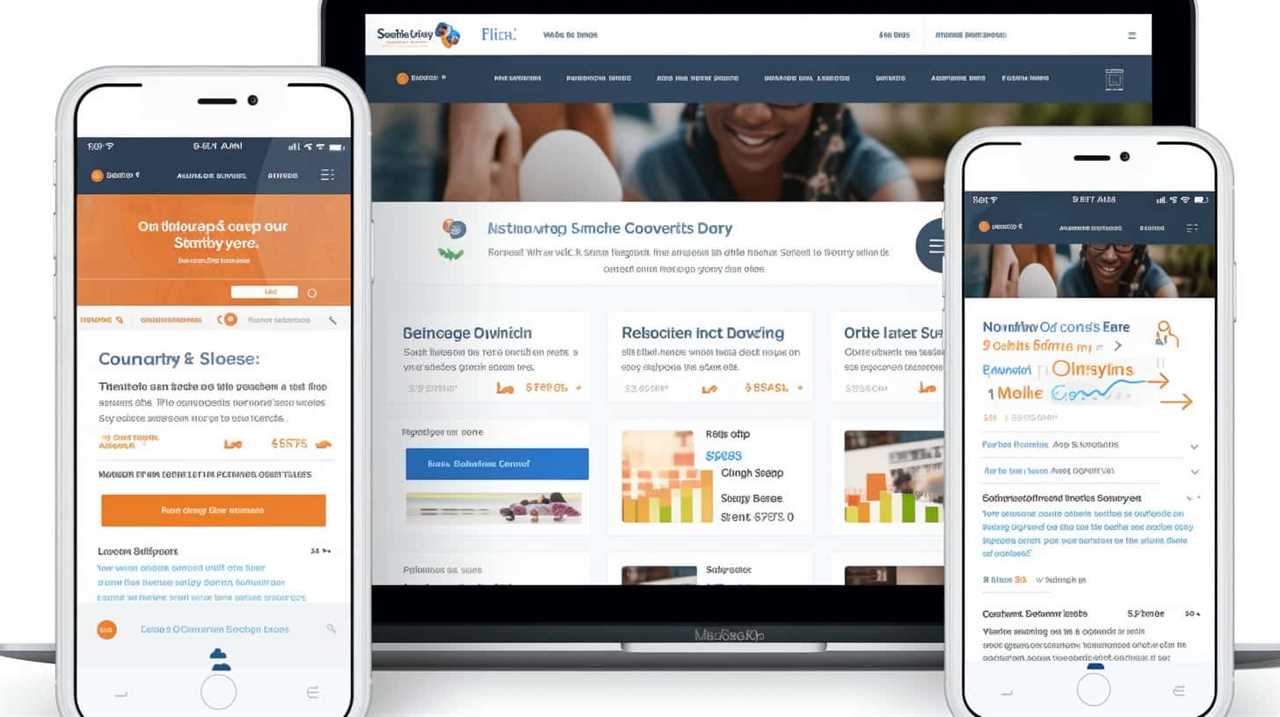Are you ready to unlock the secrets of conversion alchemy? Dive into a journey where targeted impact meets skyrocketing sales.
In this article, we’ll delve into the power of understanding your target audience, identifying profitable niche markets, and tailoring your marketing messages for maximum impact.
Building trust and credibility, tracking and analyzing results – we’ll cover it all.
Get ready to master the art of niche influence and watch your sales soar.

Key Takeaways
- Niche influencers have a smaller, but more engaged and targeted audience, resulting in higher conversion rates and a stronger brand connection.
- Understanding the demographics and psychographics of the target audience helps tailor marketing strategies for maximum sales.
- Tailoring marketing strategies to resonate with the target audience through personalized advertising and niche-specific content increases engagement, trust, and loyalty, ultimately leading to higher chances of conversion and sales.
- Identifying profitable niche markets requires researching and understanding the needs and interests of the niche audience, building relationships with them, and leveraging data and analytics for insights into their behaviors and preferences.
The Power of Niche Influence
We have found that harnessing the power of niche influence can significantly boost our sales. When it comes to influencers, there’s a distinct advantage in partnering with niche influencers over mainstream influencers.
Niche influencers have a smaller, but more engaged and targeted audience. Their followers are passionate and highly interested in the specific niche they represent. This level of engagement translates into higher conversion rates and a stronger brand connection.
By leveraging niche influence for brand partnerships, we’re able to tap into a highly receptive audience that’s more likely to convert into loyal customers. Additionally, niche influencers often have a deep understanding of their audience’s needs and preferences, allowing us to tailor our messaging and offerings more precisely.
In the world of brand partnerships, niche influence is the secret ingredient that unlocks conversion magic.

Understanding Your Target Audience
To maximize sales, it’s crucial to understand your target audience on a deep level.
By analyzing audience demographics and psychographics, we can uncover valuable insights about their preferences, needs, and desires.
Armed with this knowledge, we can create tailored marketing strategies that resonate with our target audience and drive conversions.
Audience Demographics and Psychographics
Understanding our target audience’s demographics and psychographics is essential for maximizing sales and achieving conversion magic. By diving deep into the characteristics and behaviors of our buyers, we can create personalized campaigns that resonate with their needs and desires.

Here are four key reasons why understanding audience demographics and psychographics is crucial for successful marketing:
- Better targeting: Knowing the age, gender, location, and other demographic factors of our audience allows us to tailor our messaging and offers to their specific needs.
- Improved messaging: Understanding the psychographics of our audience, such as their interests, values, and motivations, helps us craft compelling messages that speak directly to their desires.
- Enhanced customer experience: When we understand our audience’s preferences and behaviors, we can create a seamless and personalized customer journey that delights and engages them.
- Increased conversions: By aligning our campaigns with the demographics and psychographics of our target audience, we can significantly boost our conversion rates and drive more sales.
Tailoring Marketing Strategies
By delving into the characteristics and behaviors of our target audience, we can effectively tailor our marketing strategies to resonate with their needs and desires. Personalized advertising and niche-specific content are two key elements that can significantly impact the success of our marketing campaigns.
Personalized advertising allows us to create customized messages that speak directly to our target audience, making them feel seen and understood. This kind of personalized approach not only increases engagement but also builds trust and loyalty.
Additionally, developing niche-specific content helps us establish ourselves as experts in our industry and attract a dedicated following. By understanding our audience’s interests and preferences, we can create content that’s relevant and valuable to them, increasing the chances of conversion and sales.

Identifying Profitable Niche Markets
When it comes to identifying profitable niche markets, we need to focus on targeting niche demographics. By understanding the specific characteristics and needs of these demographic segments, we can tailor our marketing efforts to resonate with them on a deeper level.
Additionally, conducting a profit potential analysis allows us to evaluate the viability and profitability of these niche markets before investing significant resources.
Lastly, by uncovering hidden opportunities within these niches, we can tap into underserved markets and gain a competitive advantage.
Targeting Niche Demographics
We target profitable niche markets by researching and identifying specific demographics. This allows us to tailor our marketing strategies to reach the right audience and maximize our sales potential.

When it comes to targeting niche demographics, there are several key factors to consider:
- Understanding the needs and interests: We delve deep into the niche market to understand the unique needs and interests of the target audience. This helps us craft compelling marketing messages that resonate with them.
- Identifying micro influencers: We recognize the power of micro influencers in niche markets. These individuals have a strong influence over their followers and can help us reach our target audience more effectively.
- Leveraging data and analytics: We rely on data and analytics to gain insights into the behaviors and preferences of our niche audience. This allows us to make data-driven decisions and optimize our marketing efforts.
- Building relationships: We believe in building strong relationships with our niche audience. By engaging with them through social media, forums, and other channels, we can establish trust and loyalty, leading to increased sales.
Profit Potential Analysis
To identify profitable niche markets, we analyze the profit potential of specific demographics and tailor our marketing strategies accordingly. Conducting a profit potential assessment is crucial in determining the market profitability of different niches. By evaluating factors such as customer demand, competition, and pricing dynamics, we can identify opportunities with the greatest profit potential.
To assist you in understanding this concept better, here is a table summarizing the key elements of a market profitability evaluation:
| Factors to Consider | Description |
|---|---|
| Customer Demand | Assess the level of demand for products or services within the niche market. |
| Competition | Analyze the competitive landscape and identify the strength and positioning of competitors. |
| Pricing Dynamics | Evaluate the pricing strategies and trends within the niche market. |
| Profit Potential | Determine the potential profitability of the niche market based on the above factors. |
Uncovering Hidden Opportunities
In our quest to maximize sales, we diligently uncover hidden opportunities by identifying profitable niche markets. Finding untapped markets is a crucial step in driving business growth and increasing revenue. Here are four key strategies to help you uncover hidden opportunities and capitalize on them:

- Conduct thorough market research: Analyze market trends, consumer behavior, and competitor analysis to identify gaps and untapped niches.
- Leverage niche communities: Engage with niche communities and forums to gain insights into their needs, preferences, and pain points. This will help you tailor your products or services to meet their specific demands.
- Identify underserved customer segments: Look for customer segments that are underserved by existing solutions. By understanding their unique needs, you can create targeted marketing campaigns and offerings that cater to their specific requirements.
- Innovate and differentiate: Differentiate your offerings by providing unique value propositions and innovative solutions that address the pain points of your target niche market.
Tailoring Your Marketing Messages
Crafting personalized marketing messages is key to maximizing conversion rates and driving sales.
In today’s competitive market, customers expect brands to understand their unique needs and deliver tailored messages that resonate with them.
This is where customer segmentation comes into play. By dividing your target audience into distinct groups based on their demographics, behaviors, and preferences, you can create more personalized messaging that speaks directly to their interests and motivations.
Customer segmentation allows you to customize your marketing messages to address specific pain points, highlight relevant benefits, and offer personalized solutions.

By doing so, you can increase the effectiveness of your marketing campaigns, improve customer engagement, and ultimately boost your sales.
Don’t underestimate the power of personalized messaging in capturing the attention and loyalty of your audience.
Building Trust and Credibility
As we continue our discussion on tailoring marketing messages, we now delve into the crucial aspect of building trust and credibility. Establishing authority and providing social proof are essential for gaining the trust of your audience and boosting your credibility. Here are four key strategies to achieve this:
- Showcase your expertise: Demonstrate your knowledge and expertise in your niche through informative content, case studies, and success stories.
- Leverage testimonials and reviews: Highlight positive feedback from satisfied customers to show that others have had a positive experience with your product or service.
- Partner with influencers: Collaborate with influencers in your industry to tap into their established authority and reach a wider audience.
- Display trust badges and certifications: Displaying trust symbols, such as security certifications or awards, can help instill confidence in your audience.
Tracking and Analyzing Your Results
To effectively measure the success of our marketing efforts and make data-driven decisions, we need to dive into tracking and analyzing our results. Measuring the effectiveness of our campaigns is crucial for optimizing our strategies and maximizing our sales. By tracking key metrics, we gain valuable insights into what is working and what needs improvement.

To help you understand the importance of tracking and analyzing your results, here is a table outlining some essential metrics to monitor:
| Metric | Description |
|---|---|
| Conversion Rate | The percentage of visitors who take the desired action |
| Customer Lifetime Value | The total revenue generated by a customer over their lifetime |
| Cost per Acquisition | The amount spent to acquire a new customer |
| Return on Investment | The ratio of revenue generated to the cost of the campaign |
Frequently Asked Questions
How Can I Effectively Leverage Niche Influence to Increase My Sales?
To effectively leverage niche influence and increase sales, we need to understand the power of targeting specific audiences and crafting tailored messages. By tapping into the unique needs and interests of our niche market, we can drive higher conversion rates and boost our bottom line.
What Are Some Common Mistakes to Avoid When Trying to Understand My Target Audience?
When trying to understand our target audience, we must avoid common mistakes like assuming we know what they want or neglecting to collect data. Mastery requires a data-driven approach and avoiding these pitfalls.
How Do I Identify Profitable Niche Markets That Align With My Products or Services?
To identify profitable niche markets that align with our products or services, we must conduct thorough market research, analyze customer data, and track industry trends. This data-driven approach enables us to strategically target our ideal audience for maximum sales impact.

What Are Some Strategies for Tailoring My Marketing Messages to Resonate With My Target Audience?
Tailoring strategies for marketing messages involve understanding our target audience. By analyzing their preferences and needs, we can create personalized and impactful messages that resonate like a catchy tune, driving sales and fostering customer loyalty.
What Are the Key Factors in Building Trust and Credibility With My Niche Market?
Building relationships and establishing expertise are key factors in building trust and credibility with our niche market. By consistently delivering valuable content, demonstrating industry knowledge, and engaging with our audience, we can gain their trust and become a go-to resource in our field.
Conclusion
In the world of sales, the power of niche influence is like a magician’s wand, casting a spell of conversion.
By understanding our target audience and identifying profitable niche markets, we can tailor our marketing messages to resonate with them on a personal level.

Building trust and credibility solidifies our position as experts in our niche.
Through tracking and analyzing our results, we can continuously refine our strategies and achieve remarkable sales growth.
Let the magic of niche influence transform your business today.










